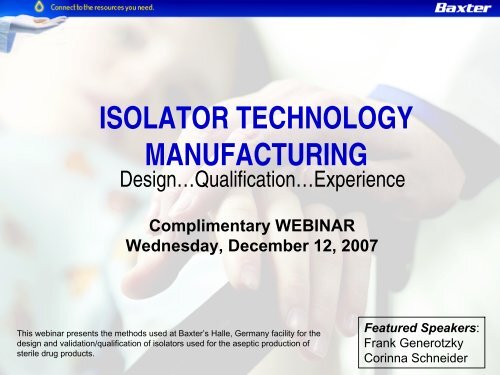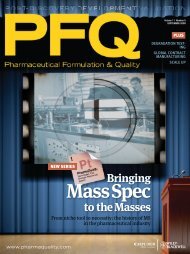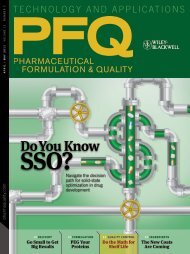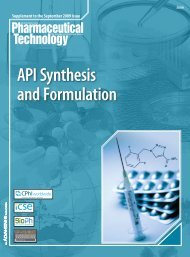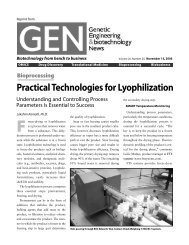Can't Touch This! The Three W's of Barrier Isolator Technology
Can't Touch This! The Three W's of Barrier Isolator Technology
Can't Touch This! The Three W's of Barrier Isolator Technology
Create successful ePaper yourself
Turn your PDF publications into a flip-book with our unique Google optimized e-Paper software.
ISOLATOR TECHNOLOGY<br />
MANUFACTURING<br />
Design…Qualification…Experience<br />
Complimentary WEBINAR<br />
Wednesday, December 12, 2007<br />
<strong>This</strong> webinar presents the methods used at Baxter’s Halle, Germany facility for the<br />
design and validation/qualification <strong>of</strong> isolators used for the aseptic production <strong>of</strong><br />
sterile drug products.<br />
Featured Speakers:<br />
Frank Generotzky<br />
Corinna Schneider
Speakers<br />
Frank<br />
Generotzky<br />
Director <strong>of</strong><br />
<strong>Technology</strong> and<br />
Engineering<br />
Mr. Frank Generotzky is recognized as an expert in the<br />
field <strong>of</strong> aseptic manufacturing <strong>of</strong> parenteral products, and<br />
is a frequent presenter at several European Conferences<br />
and ISPE Meetings for Sterile Drug Manufacturing. He<br />
earned his Diploma for Pharmaceutical Engineering from<br />
the University <strong>of</strong> Applied Science Lippe / Höxter in<br />
Germany.<br />
Since 1996 Frank has designed and installed several<br />
production-lines in standard Cleanroom <strong>Technology</strong> as<br />
well as in <strong>Isolator</strong> <strong>Technology</strong> at Baxter’s facility in Halle,<br />
Germany. Starting in 2001 Frank headed the production<br />
department for sterile cytotoxic drugs (liquid, powders and<br />
lyophilisates).<br />
In his present role, Frank is responsible for the strategic<br />
development <strong>of</strong> Pharmaceutical <strong>Technology</strong> in Halle. He<br />
is leading a team <strong>of</strong> 13 engineers, who design, plan and<br />
realize the investment projects in Halle according to<br />
customer and market requirements.<br />
Corinna<br />
Schneider<br />
QA Specialist GMP<br />
Compliance<br />
Ms. Corinna Schneider, is recognized as an expert in the<br />
field <strong>of</strong> sterile drug products produced by aseptic<br />
processing. She developed and implemented a complex<br />
VHP sterilization process for isolators and equipment<br />
parts in Halle/Germany and presented this method at<br />
pharmaceutical conferences and workshops in Europe<br />
and in the US. She trained local regulatory inspectors in<br />
VHP cycle development and presented her concept<br />
several times to the FDA. Ms. Schneider earned her<br />
Diploma for Pharmaceutical Engineering from the<br />
University <strong>of</strong> Applied Science Lippe / Höxter in Germany.<br />
From 1995 to 2000 she headed the Microbiological<br />
Quality Control Lab and focused on environmental<br />
monitoring, validation <strong>of</strong> aseptic processing, and<br />
microbial identification. In her current position in Quality<br />
Assurance she is responsible for GMP compliance,<br />
internal and external auditing, and several compliance<br />
projects to improve the effectiveness <strong>of</strong> the quality<br />
management system.<br />
2
Topics<br />
<strong>Isolator</strong> Design Criteria<br />
- Different <strong>Isolator</strong> Applications<br />
- Process Development<br />
Qualification <strong>of</strong> “critical” Design Features<br />
- Airflow Investigation Near Mouseholes<br />
- <strong>Isolator</strong> Integrity<br />
- VHP Sterilization<br />
<strong>Isolator</strong> <strong>Technology</strong> versus Conventional Cleanroom<br />
3
Designing <strong>Isolator</strong>s<br />
4
Different <strong>Isolator</strong> Applications<br />
• <strong>Isolator</strong>s for compounding and Sterilizable isolators for<br />
handling <strong>of</strong> toxic powder<br />
aseptic processing<br />
• Negative pressure isolators Positive pressure isolators<br />
(-50 Pa to -150 Pa) (25 Pa to 100 Pa)<br />
ISOLATOR<br />
ISOLATOR<br />
• <strong>Isolator</strong> for manual sterile <strong>Isolator</strong>s on automatic<br />
operations filling machines<br />
=> “Closed <strong>Isolator</strong>s” => “Open <strong>Isolator</strong>s”<br />
5
Different <strong>Isolator</strong> Applications<br />
Requirements on Containment <strong>Isolator</strong>s<br />
• Generally operated under negative pressure to ensure max. operator safety<br />
• Typically classified as ISO 7 (Class 10,000 at rest, Grade C)<br />
• <strong>The</strong>y must not exchange air with the surrounding environment<br />
(except through a HEPA filter)<br />
• Equipped with nitrogen supply if required<br />
• All materials exiting the isolator must be cleaned or contained<br />
• <strong>The</strong>y must be cleanable in a reproducible and quantifiable manner;<br />
swab-tests and tracer substances should be used during qualification<br />
6
Different <strong>Isolator</strong> Applications<br />
Containment <strong>Isolator</strong> for Compounding<br />
• negative pressure <strong>of</strong> -100 Pa, electronically controlled<br />
• interlocked isolator door after start <strong>of</strong> operation<br />
• visual display indicates permanent status <strong>of</strong> the<br />
isolator<br />
• radii in the isolator chamber >15 mm,<br />
chamber and fittings require gradient <strong>of</strong> 2 %<br />
• tightness test before each process<br />
• glove test prior to manufacturing<br />
• “push – push” system for exhaust air filters<br />
• integrated rapid transfer ports (RTP) for loading and<br />
discharging without compromising the surrounding<br />
7
Different <strong>Isolator</strong> Applications<br />
Requirements on <strong>Isolator</strong>s for Aseptic Processing<br />
• <strong>The</strong>y must not exchange air with the surrounding environment except when<br />
that air passes though a HEPA filter<br />
• Typically classified as ISO 5 (Class 100, Grade A)<br />
• <strong>The</strong>se units are typically operated under positive pressure and are subject to<br />
sterilization procedures prior to use<br />
• <strong>The</strong>y must be sterilized in a reproducible manner (VHP)<br />
• All materials that enter the isolator must be sterilized and must enter either directly<br />
through a decontaminating or sterilizing system or via a rapid transfer port<br />
8
Different <strong>Isolator</strong> Applications<br />
„Closed <strong>Isolator</strong>“ for Aseptic Operations<br />
• “Closed Box” with HEPA filter H14<br />
• discontinuously loading and discharging<br />
• all transfer processes are conducted via<br />
aseptic connections (RTP, SIP)<br />
Example: <strong>Isolator</strong> for Aseptic Filling<br />
• <strong>Isolator</strong>:<br />
- Grade A, (ISO 5)<br />
- VHP sterilization<br />
- positive pressure (+ 100Pa)<br />
• “Double Door” port-system for aseptic<br />
discharging <strong>of</strong> the isolator<br />
9
A<br />
Different <strong>Isolator</strong> Applications<br />
„Open <strong>Isolator</strong>s“ for continuous Aseptic Operations<br />
D<br />
A<br />
B<br />
A<br />
E<br />
4-6Pa.<br />
30Pa.<br />
C<br />
X<br />
B<br />
B<br />
20Pa.<br />
Vials<br />
Inspektionsmaschine 3+4<br />
Inspektionsmaschine 1+2<br />
C<br />
E<br />
F<br />
C<br />
F<br />
G<br />
Aussendekontaminationsanlage<br />
Inspektionsmaschine<br />
2560<br />
Inspektionsmaschine<br />
2540<br />
Inspektionsmaschine<br />
2520<br />
Inspektionsmaschine<br />
2500<br />
2400<br />
G<br />
D<br />
DAR-350<br />
D<br />
Andockstation<br />
f╧r Stopfen<br />
2270<br />
-10Pa.<br />
10Pa.<br />
Hubs╠ule<br />
Stopfen<br />
2295<br />
2390<br />
Ink-Jet<br />
H<br />
G<br />
F<br />
E<br />
10
Different <strong>Isolator</strong> Applications<br />
„Open <strong>Isolator</strong>s“ for continuous Aseptic Operations<br />
• Continuous supply with materials during<br />
operation, while maintaining Grad A ISO 5<br />
• Unidirectional airflow <strong>of</strong> 0.45 m/s (+/- 0.1m/s)<br />
• Safety features:<br />
- double wall design<br />
- filtration <strong>of</strong> recirculated air<br />
- pneumatic gaskets (controlled and alarmed)<br />
- CIP for containment and air ducts<br />
- emergency mode including pressure reversal<br />
11
A<br />
Different <strong>Isolator</strong> Applications<br />
„Open <strong>Isolator</strong>s“ for continuous aseptic Operations<br />
• Classifications:<br />
Filling:<br />
Capping:<br />
Support Area:<br />
ISO 5 / Grade A<br />
ISO 7 / Grade C<br />
ISO 8 / Grade D<br />
D<br />
4 Pa<br />
E<br />
A<br />
40 Pa<br />
ISO 5<br />
• VHP sterilization for ISO 5 / Grade A<br />
- stopper bowls included in VHP sterilization<br />
- CIP / SIP for filling equipment<br />
4-6Pa.<br />
30Pa.<br />
• Caps and capping equipment:<br />
- no sterilisation<br />
- controlled disinfection<br />
B<br />
B<br />
30 Pa<br />
ISO 5<br />
20Pa.<br />
• Environmental Monitoring:<br />
- particles 0.5µm, 5.0µm<br />
- viable air monitoring<br />
-surfaces (RODAC)<br />
- Temp, diff. pressure, relative humidity<br />
-10 Pa<br />
0<br />
a-<br />
e<br />
-10Pa.<br />
D<br />
C<br />
H<br />
F<br />
10Pa.<br />
G<br />
E<br />
F<br />
G<br />
D<br />
10 Pa<br />
ISO 7<br />
C<br />
Andockstation<br />
f╧r Stopfen<br />
2270<br />
Hubs╠ule<br />
Stopfen<br />
2295<br />
G<br />
12
Different <strong>Isolator</strong> Applications<br />
Example: Design HVAC<br />
• <strong>Isolator</strong>s should be equipped with independent HVAC systems<br />
zur<br />
Zentralanlage<br />
H13<br />
von<br />
Zentralanlage<br />
"Safe change"<br />
Technikebene<br />
begehbar<br />
(Tonnendach)<br />
Zwischendecke<br />
H13<br />
Abluft<br />
über Dach<br />
"Safe change"<br />
U15<br />
U15<br />
Umluft<br />
Luftaufbereitung<br />
M + P<br />
(inkl. VHP-System)<br />
Plenum<br />
H14<br />
zur<br />
Zentralanlage<br />
H13<br />
Produktionsraum<br />
Klasse D<br />
Raum 21.50<br />
U15<br />
U15<br />
U15<br />
CG - Verteiler<br />
"Safe change"<br />
max. 2 x 1.000 m³/h<br />
( während Belüftung nach VHP - Zyklus )<br />
Überdruck im <strong>Isolator</strong> 30 Pa<br />
13
Configuration <strong>of</strong> an <strong>Isolator</strong><br />
14
Mock-Up and<br />
Risk Analysis<br />
Cleaning<br />
Changeover<br />
Testrun<br />
Leak tightness<br />
Sanitization<br />
Sterilization<br />
Set-up<br />
before start<br />
Manufacturing<br />
Process IPC /<br />
Monitoring<br />
CIP<br />
Reinigung <strong>Isolator</strong>en<br />
und produktb. Teile<br />
Abfüllmaschine<br />
Justage Initiatoren<br />
Handschuhtest<br />
Beladen <strong>Isolator</strong>en<br />
Justierung<br />
Kalibrierung<br />
Filtertest<br />
Integrität <strong>Isolator</strong><br />
Dichtigkeit SIP<br />
Abfüllmaschine<br />
(SIP)<br />
<strong>Isolator</strong> (VHP)<br />
Abfüllmaschine<br />
Ausrüstung IPK<br />
Temperatur, Druck<br />
Reinigungszeit<br />
Rückstände<br />
SOP´s<br />
reproduzierbare<br />
Positionierung Beladung<br />
Grenzwerte f. Dichtigkeit<br />
SOP´s<br />
Grenzwerte IPK Waage<br />
Grenzwert Druckabfall<br />
Zeit<br />
Temperatur , Druck,<br />
Menge, Zeit, Differenzdruck<br />
Qualification /<br />
Validation<br />
Validation <strong>of</strong> aeptic processing and<br />
Cleaning Validation<br />
Reinigungseffizienz<br />
Validierung Beladung<br />
Grenzwert Druckabf.<br />
Sterilisation von:<br />
- Stopfen<br />
- produktberühr. Teile<br />
- VHP <strong>Isolator</strong><br />
Formatbezogene<br />
Vorgaben zur Maschineneinstellung<br />
Qualifizierung der zul.<br />
Dichtigkeit<br />
Validierung der<br />
VHP Sterilisation<br />
und SIP<br />
MA Qualifizierung Qualifizierung<br />
Reinraums<br />
Füllmenge<br />
Monitoring (physik. /mikrobiologisch)<br />
v (Luft) p (diff.), T (Luft) rel. Feuchte<br />
(Luft), 100% Inspektion<br />
Qualifizierung der<br />
Transfersysteme<br />
15
Process Development<br />
Mock-up Study (Model Scale 1:1)<br />
- determination <strong>of</strong> the size; use 1:1 drawings <strong>of</strong> all machines in the isolator<br />
- simulate loading (tools, agar, probes …)<br />
- determine positions for particle counting and viable air monitoring<br />
- determine ports for validation purpose (t, p, rel. humidity, NIR, filter integrity …)<br />
- determine position for gloves carefully<br />
- define interfaces for HVAC, media, computer-systems, supplier <strong>of</strong> filling-machine …<br />
- use CIP / SIP where ever possible, reduce manual handling<br />
Simulation <strong>of</strong> all operations in the isolator<br />
- change <strong>of</strong> product contacting parts<br />
- simulate monitoring<br />
- adjustment <strong>of</strong> sensors or leadings<br />
- solve technical problems (jam <strong>of</strong> vials or stoppers ..)<br />
16
Qualification <strong>of</strong> an <strong>Isolator</strong><br />
17
Qualification <strong>of</strong> “critical” Design Features<br />
<strong>Isolator</strong>s require a high level <strong>of</strong> qualification and<br />
validation with focus on:<br />
• Airflow Investigation Near Mouseholes<br />
• <strong>Isolator</strong> Integrity<br />
• Vaporised Hydrogen Peroxid (VHP) Sterilization<br />
18
Inspectional Findings: <strong>Isolator</strong> Qualification<br />
(R. Friedmann & J. Agalloco*)<br />
• Dynamic filling line conditions not evaluated. Filling line was not in<br />
operation during smoke studies.<br />
• Smoke studies did not evaluate the pressure changes caused by<br />
introducing a glove into the isolator, or retrieving the glove from the isolator.<br />
• <strong>The</strong>re was no data documenting isolator airflow parameters, such as air<br />
pressurization and velocities, during smoke studies. <strong>The</strong> acceptability <strong>of</strong><br />
the lower air pressure limit was not evaluated.<br />
* Presentation by R. Friedman & J. Agalloco; Agallaco & Ass., NJ 2004<br />
19
Qualification <strong>of</strong> <strong>Isolator</strong> Integrity near Mouseholes<br />
PDA TR 34 Appendix B L-R Method<br />
• In this test a concentration <strong>of</strong> particles with a mean size<br />
<strong>of</strong> approximately 0.5 µm is generated within 5-10 cm <strong>of</strong> the<br />
isolator opening.<br />
Grade A<br />
+30 Pa<br />
• <strong>The</strong> particle concentration should be in the range <strong>of</strong><br />
100,000-1,000,000 per m³.<br />
• An electronic particle counter calibrated to the 0.5µm<br />
particulate size is used to scan the opening from inside the<br />
isolator. <strong>The</strong> particle counts observed on the isolator side<br />
<strong>of</strong> the opening should not be significantly different from<br />
the background count at the same location.<br />
Grade C<br />
+10 Pa<br />
In the measuring location (critical region) the number <strong>of</strong> particles per unit volume<br />
should be less than 0.01% <strong>of</strong> the initial challenge level to assure absence <strong>of</strong><br />
airborne microbial contamination under routine operational conditions.<br />
20
<strong>Isolator</strong> Integrity<br />
Leak-Testing<br />
• Pressure Hold Test - positive pressure isolators<br />
- Test pressure: operating pressure x 2<br />
- less than 0.5% <strong>of</strong> the total volume <strong>of</strong> the isolator<br />
per hour is acceptable<br />
• Pressure Drop Test - negative pressure isolators<br />
- Test pressure: -200Pa<br />
- max. 50 Pa rise <strong>of</strong> pressure 6 min is acceptable<br />
• Gloves (Hypalon 0.8 mm): - Test pressure: 500 Pa after “stressing” the glove<br />
- less than 50 Pa in 4 min<br />
- supported by physical / microbial qualifications<br />
and trend analysis<br />
21
VHP Sterilization<br />
Examples <strong>of</strong> Inspectional FDA Findings<br />
(R. Friedmann & J. Agalloco)<br />
• “Decontamination validation cycle study did not evaluate the actual<br />
commercial cycle. Validation runs were conducted at levels which <strong>of</strong>ten<br />
exceeded the proposed hydrogen peroxide decontamination<br />
concentration setpoint <strong>of</strong> *** mg/l by as much as 30 - 90%.”<br />
• “No actual measurements <strong>of</strong> concentration <strong>of</strong> sterilant that circulated<br />
within the expansive isolator. Only indirect measurements (e.g., internal<br />
VHP 1001 generator results for flow rate and H2O2 mg/l) to monitor VHP<br />
concentration.”<br />
• “<strong>The</strong> VHP decontamination studies for the isolator did not provide an<br />
adequate challenge <strong>of</strong> the cycle to determine the weak points <strong>of</strong> VHP<br />
distribution/ penetration (i.e., where air flow is most variable or<br />
potentially compromised).”<br />
* Presentation by R. Friedman & J. Agalloco; Agallaco & Ass., NJ 2004<br />
22
VHP Sterilization<br />
Examples <strong>of</strong> Inspectional FDA Findings<br />
(R. Friedmann & J. Agalloco)<br />
• “Many worst-case locations were not evaluated. Some examples:<br />
- Between fingers <strong>of</strong> installed isolator gloves. Four <strong>of</strong> nineteen filling<br />
isolator gloves were evaluated, and only at the outside <strong>of</strong> the cuff<br />
- Occluded surface created by folding the glove into its gauntlet (sleeve)<br />
during the VHP cycle<br />
- the stopper bowl locations <strong>of</strong> most concern (e.g., low point in the bowl)”<br />
• “VHP study inappropriately applied fraction negative mathematics to<br />
the vaporized hydrogen peroxide process. <strong>The</strong> fraction negative<br />
mathematical approach is fundamentally premised on essentially uniform<br />
distribution <strong>of</strong> the sterilant, and use <strong>of</strong> replicates.”<br />
* Presentation by R. Friedman & J. Agalloco; Agallaco & Ass., NJ 2004<br />
23
100 %<br />
Concentration<br />
relative<br />
humidity<br />
24<br />
Conditioning<br />
Sterilization<br />
high<br />
low<br />
Cycle<br />
Phases<br />
relative humidity<br />
Condensation<br />
0 %<br />
H 2<br />
O 2<br />
-Concentration<br />
Dehumidification<br />
Aeration<br />
VHP Sterilization<br />
VHP Process<br />
H2 O 2 -
VHP Sterilization<br />
VHP Cycle Development<br />
Sterilization Target:<br />
12-log-Reduction = overkill Process<br />
• Measurement <strong>of</strong> Process Parameters<br />
• Use <strong>of</strong> Biological Indicators<br />
• Determination <strong>of</strong> D-Value<br />
25
VHP Sterilization<br />
Process Parameters<br />
Temperature • Determination <strong>of</strong> temperature differences in the <strong>Isolator</strong><br />
• Reproducibility <strong>of</strong> temperature pr<strong>of</strong>iles<br />
Relative Humidity • Development <strong>of</strong> conditioning phase:<br />
Determination <strong>of</strong> time to reach max. relative humidity<br />
• Reproducibility <strong>of</strong> RH-pr<strong>of</strong>ile<br />
VHP-Concentration • Development <strong>of</strong> conditioning phase:<br />
Determination <strong>of</strong> time to reach max. VHP concentration<br />
• Reproducible run <strong>of</strong> concentration curve<br />
• Definition <strong>of</strong> “worst case” environmental conditions:<br />
low gas concentration at low temperatures in the isolator<br />
VHP-Distribution • Uniform distribution <strong>of</strong> VHP with chemical indicators<br />
VHP-Flow • Unidirectional/turbulent VHP Flow, airflow pattern<br />
26
VHP Sterilization<br />
Biological Indicator<br />
Type • Geobacillus stearothermophilus ATCC 12980,<br />
10 6 spores on stainless steel carrier<br />
Locations • 5 - 10 BIs per m 3<br />
• Masked locations like fingers or crinkles <strong>of</strong><br />
gloves or rails for stoppers<br />
• Documented rationale for each BI location<br />
• Short cycles for identification <strong>of</strong><br />
worst case locations => non-sterile BIs<br />
27
VHP Sterilization<br />
Biological Indicator<br />
No correlation between process parameters<br />
and results <strong>of</strong> BIs !<br />
Determination <strong>of</strong> worst case locations exclusively<br />
based on kill-pattern <strong>of</strong> BIs !<br />
28
VHP Sterilization<br />
Determination <strong>of</strong> D-value<br />
log Population<br />
7,0<br />
6,0<br />
5,0<br />
4,0<br />
3,0<br />
2,0<br />
1,0<br />
0,0<br />
-1,0<br />
-2,0<br />
-3,0<br />
-4,0<br />
-5,0<br />
-6,0<br />
-7,0<br />
Survival-Kill-Window Filling <strong>Isolator</strong><br />
Survival<br />
Fractional<br />
range<br />
t [Min.]<br />
0 2 4 6 8 10 12 14 16 18 20 22 24 26 28 30<br />
Kill<br />
Sterilization Time for a 12-log-Reduction (worst case location):<br />
Sterilization Time (worst case) = D worst case -Value x 12 = X min<br />
29
VHP Sterilization<br />
Validation <strong>of</strong> VHP Sterilization<br />
Requirements for Starting Validation<br />
• Completion <strong>of</strong> all IQ/OQ activities<br />
• Completion <strong>of</strong> cycle development<br />
Validation<br />
• 3 runs<br />
• Worst case = non operating isolator for min <strong>of</strong> 12h<br />
Acceptance Criteria<br />
• All BIs sterile<br />
• Defined H 2 O 2 consumption<br />
• Color change <strong>of</strong> chemical indicator<br />
• Room conditions within limits (T, RH)<br />
30
VHP Sterilization<br />
Lessons learned<br />
Efficiency and reproducibility <strong>of</strong> VHP sterilization<br />
can only be ascertained and verified using a<br />
microbiological system<br />
Individual D-Value determination is required for each<br />
isolator based on the “worst case” BI location<br />
31
<strong>Isolator</strong> <strong>Technology</strong> vs<br />
Conventional Cleanroom<br />
32
<strong>Isolator</strong> <strong>Technology</strong> vs Conventional Cleanroom<br />
Experiences gathered during Manufacturing<br />
Quality <strong>of</strong> the aseptic environment in the <strong>Isolator</strong><br />
<strong>Isolator</strong> <strong>Technology</strong> Cleanroom <strong>Technology</strong> Result<br />
- VHP sterilization acts<br />
sporicidal and validation<br />
is possible<br />
- VHP is effective on all<br />
accessible surfaces<br />
- Sanitization with<br />
Isopropanol / WFI : 70/30<br />
does not act sporicidal,<br />
validation is not possible<br />
- Spraying <strong>of</strong> a disinfectant<br />
is less effective<br />
Sterility can be<br />
maintained more reliable<br />
in an reduced aseptic<br />
environment with a<br />
controlled sterilization<br />
method<br />
=> pro <strong>Isolator</strong><br />
33
<strong>Isolator</strong> <strong>Technology</strong> vs Conventional Cleanroom<br />
Experiences Gathered during Manufacturing<br />
Quality <strong>of</strong> the “Conventional Cleanroom versus <strong>Isolator</strong>s”:<br />
<strong>Isolator</strong> <strong>Technology</strong> Cleanroom <strong>Technology</strong> Result<br />
- Main source <strong>of</strong> micro<br />
organism excluded:<br />
the operators<br />
- Process is protected<br />
by a solid barrier<br />
- Personnel necessary<br />
to run the process<br />
- Process is protected<br />
by aseptic techniques<br />
and unidirectional airflow<br />
- Conventional<br />
cleanroom technology<br />
is more sensitive to<br />
human failures<br />
=> pro <strong>Isolator</strong><br />
34
<strong>Isolator</strong> <strong>Technology</strong> vs Conventional Cleanroom<br />
Experiences gathered during Manufacturing<br />
Results after 5 years Monitoring<br />
• Viable Air Monitoring:<br />
Exceeded limits in Grade 100 (ISO 5) <strong>Isolator</strong>s: = 0<br />
Exceeded limits in Grade 100 (ISO 5) sterile core area: = 0<br />
• Particles (continuous monitoring 0.5µm / 5.0µm):<br />
Exceeded limits in Grade 100 (ISO 5) <strong>Isolator</strong>s < 0.001%<br />
Exceeded limits in Grade 100 (ISO 5) sterile core area: > 0.01%<br />
• Glove, Sleeve, Overall Monitoring:<br />
Exceeded limits in Grade 100 (ISO 5) <strong>Isolator</strong>s : = 0<br />
Exceeded limits in Grade 100 (ISO 5) sterile core area: > 0.1%<br />
• Surface Monitoring:<br />
Exceeded limits in Grade 100 (ISO 5) <strong>Isolator</strong>s: = 0<br />
Exceeded limits in Grade 100 (ISO 5) sterile core area: > 0.1%<br />
35
<strong>Isolator</strong> <strong>Technology</strong> vs Conventional Cleanroom<br />
Experiences gathered during Manufacturing<br />
Flexibility<br />
<strong>Isolator</strong> <strong>Technology</strong> Cleanroom <strong>Technology</strong> Result<br />
- inflexible processes<br />
- poor accessibility<br />
- limited feasibility for<br />
handling and<br />
transfers<br />
- process design flexible<br />
- accessibility not limited<br />
- process design can be<br />
adapted to different<br />
requirements<br />
<strong>Isolator</strong> <strong>Technology</strong> is<br />
limited suited for<br />
flexible processes<br />
with manual handling<br />
=> pro Cleanroom<br />
36
<strong>Isolator</strong> <strong>Technology</strong> vs Conventional Cleanroom<br />
Experiences gathered during Manufacturing<br />
Economic Efficiency<br />
<strong>Isolator</strong> <strong>Technology</strong> Cleanroom <strong>Technology</strong> Result<br />
Mechanical trouble leads<br />
to termination <strong>of</strong><br />
processes<br />
More flexibility regarding<br />
troubleshooting<br />
Risk <strong>of</strong> losing<br />
batches is lower in a<br />
conv. cleanroom<br />
=> pro Cleanroom<br />
Reduction <strong>of</strong> costs for<br />
environmental monitoring<br />
and gowning possible<br />
High costs for energy,<br />
environmental monitoring<br />
and gowning<br />
Reduced costs for<br />
maintaining Class 100<br />
=> <strong>Isolator</strong><br />
Operating in three shifts<br />
is possible<br />
Daily disinfection and<br />
recovery time is required.<br />
Increased overall<br />
time for operations<br />
=> <strong>Isolator</strong><br />
37
<strong>Isolator</strong> <strong>Technology</strong> vs Conventional Cleanroom<br />
“Lessons Learned” Efficiency<br />
1. Changeover / Conversion:<br />
Sterile Core Area:<br />
<strong>Isolator</strong>:<br />
Changeover, test-run, disinfection<br />
Sum: 3 h to 4 h<br />
7 h VHP sterilization + venting to limit 1 ppm<br />
7.5 h cleaning + change over + test-run<br />
Sum: 15.50 h<br />
2. Termination <strong>of</strong> Manufacturing Process:<br />
<strong>Isolator</strong> 2003: ca. 2.5 %<br />
Sterile Core Area : 0<br />
<strong>Isolator</strong> 2004: ca. 1.5 %<br />
Sterile Core Area : 0<br />
<strong>Isolator</strong> 2005: ca. 1.2 %<br />
Sterile Core Area : 0<br />
38
Summary …<br />
…after five years experience with <strong>Isolator</strong> <strong>Technology</strong> designed and<br />
build for the supply <strong>of</strong> the world wide market with cytostatics<br />
Would we choose <strong>Isolator</strong> <strong>Technology</strong> again <br />
Yes regarding maximum achievable product quality<br />
Yes regarding operator safety (EHS)<br />
Yes regarding process complexity and process stability<br />
Yes regarding economic efficiency<br />
Is the isolator basically the best concept for aseptic processing <br />
Not always ...<br />
but more and more!<br />
http://www.baxterbiopharmasolutions.com/contract_manufacturing/facilities_equipment/halle_germany.html<br />
39


